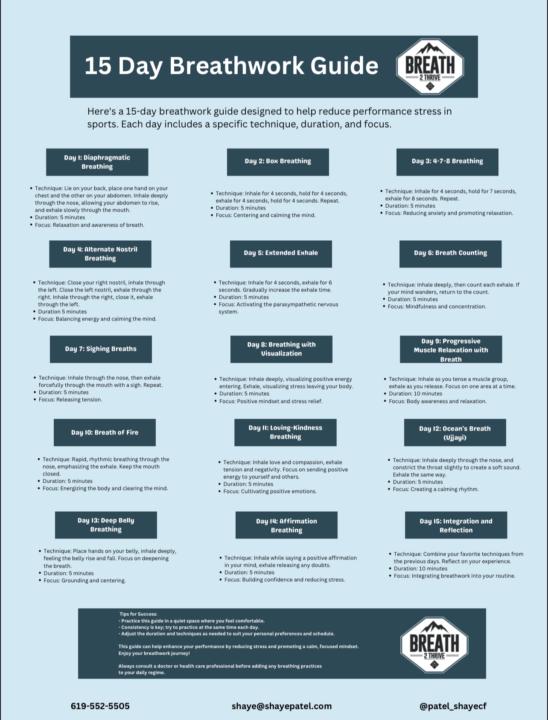Activity
Mon
Wed
Fri
Sun
Oct
Nov
Dec
Jan
Feb
Mar
Apr
May
Jun
Jul
Aug
Sep
What is this?
Less
More
Owned by Shaye
Welcome to the Breath 2 Thrive. A community for individuals to improve their personal, professional, and athletic performance through breath.
Memberships
Rotger Elite Performance
282 members • Free
72 contributions to Breath 2 Thrive
15 Day Breathwork Guide PDF
Hey Y'all, I wanted to share this PDF I put together. Please let me know if you have any questions.

UNDERSTANDING STRESS: THE BALANCE BETWEEN HOMEOSTASIS AND ALLOSTASIS
Stress isn’t always the enemy. In fact, it’s essential for growth, performance, and survival. But the way your body handles stress determines whether it builds you up—or breaks you down. Let’s look at two key concepts behind this: homeostasis and allostasis. HOMEOSTASIS: YOUR BODY’S BASELINE Homeostasis is your body’s “default mode”—a steady internal state where systems like heart rate, temperature, and pH are kept within narrow, optimal ranges. When you’re calm and recovered, your body prioritizes rest, digestion, and repair. This is your physiological ground zero. ALLOSTASIS: ADAPTATION IN ACTION Allostasis is what kicks in when you’re under pressure. It’s how your body achieves stability through change—activating stress hormones like cortisol and adrenaline, increasing your heart rate, and sharpening focus so you can perform under pressure. Stressful situations—whether it’s a workout, a big presentation, or emotional conflict—rely on allostasis to help you adapt in real time. THE DOWNSIDE: ALLOSTATIC LOAD When stress is short-lived, allostasis helps you grow. But if it becomes chronic, or recovery is poor, your body never fully returns to baseline. Over time, this builds allostatic load—the wear and tear on your brain and body. Symptoms? Fatigue, poor sleep, inflammation, low resilience, and eventually burnout. THE SOLUTION: TRAIN YOUR STRESS RESPONSE Resilience isn’t about avoiding stress—it’s about recovering well. Tools like breathwork, sleep hygiene, contrast therapy, and mindfulness train your nervous system to return to homeostasis faster. The goal? Stay adaptable. Stress to grow, then return to calm. TAKEAWAY Stress isn’t bad. Staying stressed is. Learn to shift between stress (allostasis) and recovery (homeostasis), and you’ll unlock a new level of performance and well-being. — Want to learn how to build your stress resilience and train your nervous system like a high performer? Please reach out!
4
0
Power of Nasal Breathing on Athletic Performance
https://cdn5.dcbstatic.com/files/x/p/xptlife_docebosaas_com/1745517600/oOYpJw1YvVhQtq0ZvPobOA/item/a43a77d988822130546ed43c7409ba88c13834fa.pdf This research presentation titled "The Effects of Nasal Breathing on Exercise Tolerance" by Thomas et al. (2009), presented at the Chartered Society of Physiotherapy Annual Congress. The study investigates the impact of nasal-only breathing on exercise performance in healthy university students. Key Findings: - Nasal Breathing Benefits: Nasal breathing filters, warms, and moistens the air, providing cleaner and more optimal conditions for the lungs compared to mouth breathing. It also adds nitric oxide to inspired air, which acts as a bronchodilator and vasodilator, enhancing respiratory efficiency. - Exercise Performance: The study aimed to determine whether individuals could maintain nasal breathing during incremental exercise and how it affects exercise tolerance. While the specific results are not detailed in the provided excerpt, the research suggests that training individuals to sustain nasal breathing during physical activity could improve exercise performance and respiratory health. - Implications for Physiotherapy: The findings highlight the importance of incorporating nasal breathing techniques into physiotherapy practices, especially for patients with respiratory conditions. It suggests that physiotherapists should consider training individuals to prolong nasal breathing during exercise to enhance respiratory function and overall health. This research underscores the significance of nasal breathing in maintaining optimal respiratory health and its potential benefits in improving exercise tolerance. Let me know what you think.
5
0
HYROX - PERFORMANCE BREATHING EBOOK
Really excited to share this with y’all! I just wrote and ebook focusing on improving your performance for HYROX training and competitions! I hope y’all would considering purchasing one! They are $6.99 each and you can download the pdf twice! Thank you all for your support! https://djpf9d-9e.myshopify.com/products/hyrox-performance-breathing-ebook?utm_source=copyToPasteBoard&utm_medium=product-links&utm_content=web
CROSSFIT OPEN 2025
Breath 2 Thrive Breathing Protocol to Dominate the OPEN 💨💪 Level up your 2025 Open performance with the Breath 2 Thrive breathing protocol! Control your breath, control your workout. Here’s how: PRE-WORKOUT: Prime Your System * Mindful Activation (10 mins): * Find a quiet zone. Part 1: Down Regulation: * Box Breathing: 4 seconds inhale, 4 seconds hold, 4 seconds exhale, 4 seconds hold. 5-10 rounds. Purpose: Calm the nervous system, reduce pre-workout jitters. * Diaphragmatic Deep Breathing: Hand on belly, hand on chest. Focus on belly rise/fall. Purpose: Maximize lung capacity, engage core. Part 2: Upper Regulation 3 x 25 seconds of quick inhales through the nose and exhales through the mouth) *you may feel a little light headed so sit or lay down on the ground! * This pre work prepares the athlete to enter the workout with a calm and focused mindset. DURING-WORKOUT: Stay Present, Stay Powered * Breath Awareness: * During transitions (even short ones), take 2-3 deep, deliberate breaths. * Match your breath to the movement: Inhale on the easier phase, exhale on the exertion. * If you feel your heartrate becoming too high, focus on slowing the exhale. * Avoid Panic Breathing: * Fight the urge for rapid, shallow breaths. Stay conscious of deep, controlled breathing. * This practice will help the athlete maintain a more even heartrate, and therefore maintain a higher level of performance. POST-WORKOUT: Recharge & Recover * Recovery Breathing (5-10 mins): * Extended Exhale: Inhale 4 seconds, exhale 8 seconds. Shift to parasympathetic state (rest/digest). * Continue diaphragmatic breathing. * This is the time to bring the body back to a resting state, and to begin the recovery process. * Fuel & Hydrate: * Support recovery with proper nutrition and hydration. Breathing is only one part of recovery. Key Points: * Consistent practice is key! Integrate these techniques into your daily training. * Breath control enhances focus, reduces fatigue, and accelerates recovery.
5
0
1-10 of 72
@shaye-patel-4533
Welcome to a community where you can learn to be you through strengthening your mental and physical fitness.
Active 4h ago
Joined Oct 1, 2024
Powered by

